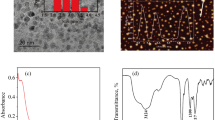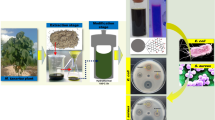Abstract
Antibiotics have been widely used as fundamental medicine for several decades to treat various bacterial infections. However, bacteria develop different mechanisms to defeat the action of antibiotics, which has become a significant issue that endangers infectious therapy. To reduce the consumption of antibiotics and thus combat the increasing antibiotic resistance, it is necessary to implement safe and effective alternatives to conventional antibiotics. Though nanomaterials have become an emerging hope in infectious treatments, they have limited application due to aggregation, toxicity issues, and problems related to their dispersibility. However, carbon nanomaterials (CNMs) offer high solubility, biocompatibility, and minimum toxicity with their inherent antibacterial properties. The selection of natural precursors as the carbon source is an eco-friendly and economical route for synthesizing antibacterial carbon nanomaterials. In the present work, fluorescent CNMs have been synthesized by the hydrothermal treatment of Alstonia venenata leaf extract. The antibacterial capability of the bare extract (AVE), hydrothermally treated extract (AVH), AVH doped with nitrogen (N-AVH), and AVH doped with phosphorous (P-AVH) are tested against gram-positive Staphylococcus aureus (S. aureus) and gram-negative Escherichia coli (E. coli) bacteria. Except for P-AVH, all other samples showed nontoxicity towards the tested bacterial species. In contrast, P-AVH inhibited bacterial growth with minimum inhibitory concentration (MIC) values of 2.5 and 2 mg/ml on S. aureus and E. coli, respectively.
Access this chapter
Tax calculation will be finalised at checkout
Purchases are for personal use only
Similar content being viewed by others
References
Yin R, Agrawal T, Khan U, Gupta GK, Rai V, Huang YY et al (2015) Antimicrobial photodynamic inactivation in nanomedicine: small light strides against bad bugs. Nanomedicine 10(15):2379–2404
Razack IJ, Thomas A, Kota S, Varghese M, Chiriyankandath JS, Nair AS (2020) Graphene based materials for supercapacitors. Mapana J Sci 19(1):87–137
Saikia M, Singh A, Dihingia A, Khare P, Kalita J, Saikia BK (2022) Scalable production, cell toxicity assessment, and plant growth promotion activities of carbon quantum dots derived from low-quality coal feedstock. Chem Eng J 433:133633
Luan X (2022) Heating properties of graphene oxide nanosheets and their application in clothing design. Adv Mater Sci Eng 2022:1457
Rao AA, Joseph AP, Balachandran M (2022) An outlook on zero-dimensional nanocarbons as components of DSSC. Biomass Convers Biorefinery 14:1–23
Venkatesan RA, Balachandran M (2020) Novel carbon nano-onions from paraffinum liquidum for rapid and efficient removal of industrial dye from wastewater. Environ Sci Pollut Res 27(35):43845–43864
Varghese M, Balachandran M (2021) Antibacterial efficiency of carbon dots against gram-positive and gram-negative bacteria: a review. J Environ Chem Eng 9(6):106821
Zhou LJ, Chi YT, Chen LS, Pei SC, Chai SQ (2022) One-step synthesis of si-doped carbon dots with antibacterial activities. Russ J Gen Chem 92(11):2363–2369
Travlou NA, Giannakoudakis DA, Algarra M, Labella AM, Rodríguez-Castellón E, Bandosz TJ (2018) S- and N-doped carbon quantum dots: surface chemistry dependent antibacterial activity. Carbon 135:104–111
Ezati P, Rhim JW, Molaei R, Priyadarshi R, Roy S, Min S et al (2022) Preparation and characterization of B, S, and N-doped glucose carbon dots: antibacterial, antifungal, and antioxidant activity. Sustain Mater Technol 32:e00397
Chai S, Zhou L, Pei S, Zhu Z, Chen B (2021) P-doped carbon quantum dots with antibacterial activity. Micromachines 12(9):1116
Lin R, Cheng S, Tan M (2022) Green synthesis of fluorescent carbon dots with antibacterial activity and their application in Atlantic mackerel (Scomber scombrus) storage. Food Funct 13(4):2098–2108
Chai S, Zhou L, Chi Y, Chen L, Pei S, Chen B (2022) Enhanced antibacterial activity with increasing P do** ratio in CQDs. RSC Adv 12(43):27709–27715
Başoğlu A, Ocak Ü, Gümrükçüoğlu A (2020) Synthesis of microwave-assisted fluorescence carbon quantum dots using roasted–chickpeas and its applications for sensitive and selective detection of Fe3+ ions. J Fluoresc 30(3):515–526
Kalaiyarasan G, Joseph J, Kumar P (2020) Phosphorus-doped carbon quantum dots as fluorometric probes for iron detection. ACS Omega 5(35):22278–22288
Author information
Authors and Affiliations
Corresponding author
Editor information
Editors and Affiliations
Rights and permissions
Copyright information
© 2023 The Author(s), under exclusive license to Springer Nature Singapore Pte Ltd.
About this paper
Cite this paper
Varghese, M., Kootery, K.P., Saro**i, S., Balachandran, M. (2023). Antibacterial Effect of Phosphorous-Doped Carbon Nanomaterial Derived from Alstonia Venenata. In: Khan, Z.H., Jackson, M., Salah, N.A. (eds) Recent Advances in Nanotechnology. ICNOC 2022. Springer Proceedings in Materials, vol 28. Springer, Singapore. https://doi.org/10.1007/978-981-99-4685-3_46
Download citation
DOI: https://doi.org/10.1007/978-981-99-4685-3_46
Published:
Publisher Name: Springer, Singapore
Print ISBN: 978-981-99-4684-6
Online ISBN: 978-981-99-4685-3
eBook Packages: Chemistry and Materials ScienceChemistry and Material Science (R0)




